
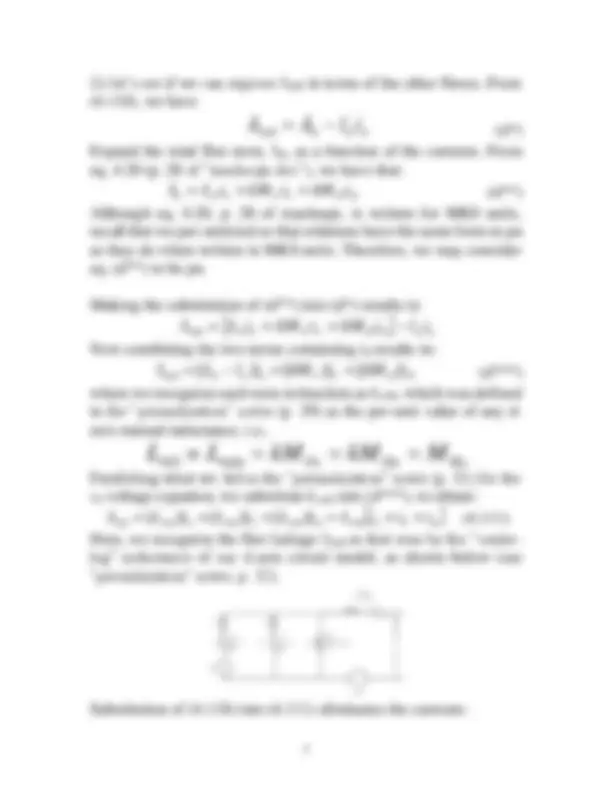
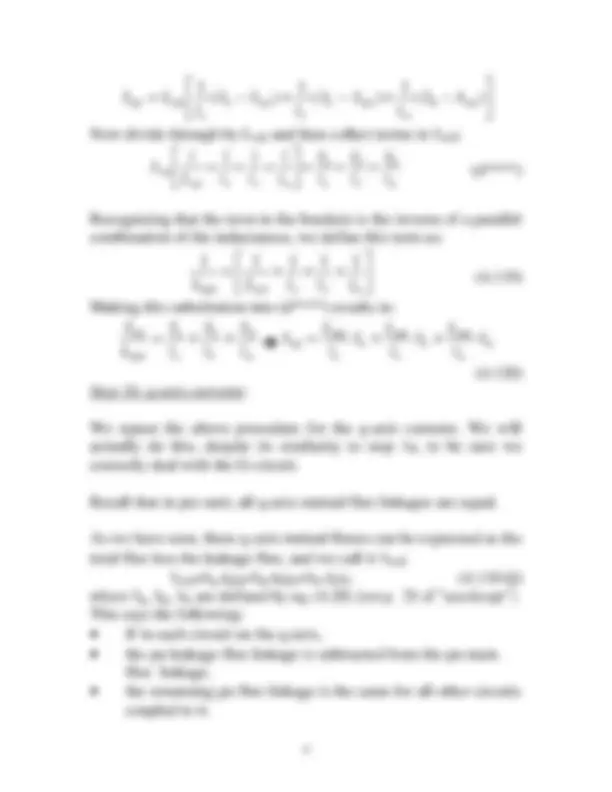
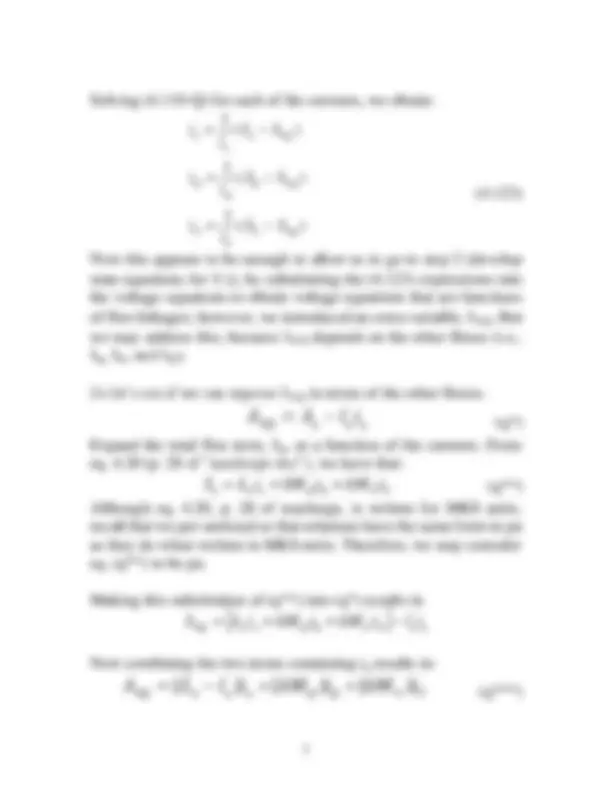
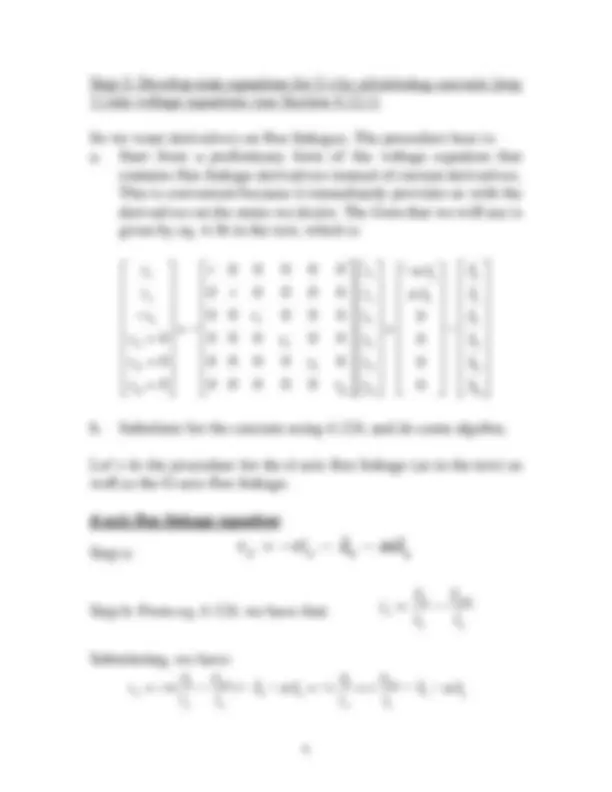
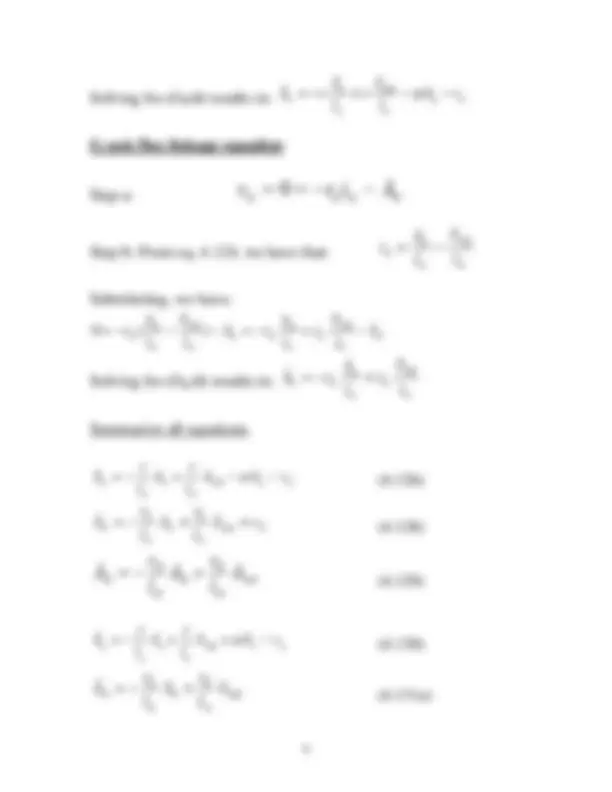
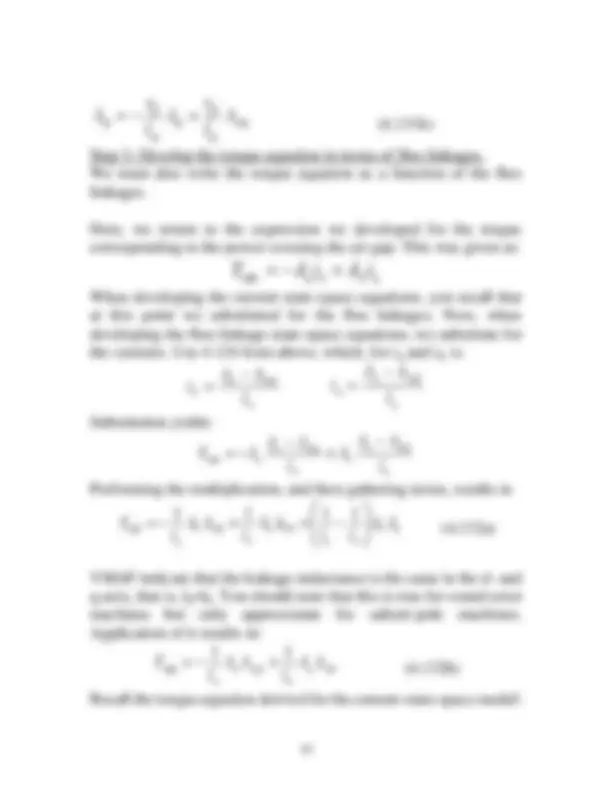


Study with the several resources on Docsity

Earn points by helping other students or get them with a premium plan


Prepare for your exams
Study with the several resources on Docsity

Earn points to download
Earn points by helping other students or get them with a premium plan
Community
Ask the community for help and clear up your study doubts
Discover the best universities in your country according to Docsity users
Free resources
Download our free guides on studying techniques, anxiety management strategies, and thesis advice from Docsity tutors
Develop state equations for λ's by substituting current expressions (from step 1) into voltage equations. 3. Develop the torque equation in terms of flux ...
Typology: Schemes and Mind Maps
1 / 12

This page cannot be seen from the preview
Don't miss anything!







Flux-Linkage State-Space Model (Section 4.12)
One limitation of the current state-space model is that the effects of saturation are difficult to represent.
This is because in the current state-space model, the effects of saturation cannot be isolated to a single current, whereas in the flux- linkage state-space model, it can. The reason saturation can be isolated to a single parameter in the flux-linkage state space model is because saturation occurs in the mutual fluxes, since mutual flux exists in the core material, which is quite saturable (i.e., the permeability decreases with high currents), whereas leakage flux exists largely external to the core material, i.e., in the air, which has permeability that is nearly constant with current.
So we will develop the flux-linkage state-space model, which uses the ’s as the state variables rather than the currents.
Our approach will follow four steps:
Step 1: Develop d- and q- axis currents as function of ’s and mutual fluxes AD and AQ:
(This comes partly from Section 4.11 and partly from 4.12) We will take three sub-steps here.
Step 1a: d-axis currents Step 1b: q-axis currents Step 1c: put them together Step 1a: d-axis currents :
Recall that in per-unit, from eqs. (4.107-4.108) (see p. 29 of “perunitization” notes), all d-axis mutuals are equal, called LAD, Ld-ld=LD-lD=LF-lF=LAD and we can replace the second and third terms to write Ld-ld=kMD=kMF=LAD As we have seen, these d-axis mutual fluxes can be expressed as the total flux less the leakage flux, and we call it AD: AD=d-ldid=F-lFiF=D-lDiD (4.110) where λd, λF, λD are defined by eq. (4.20) (see p. 28 of “macheqts”). This says the following: If in each circuit on the d-axis, the pu leakage flux linkage is subtracted from the pu main flux linkage, the remaining pu flux linkage is the same for all other circuits coupled to it. Solving (4.110) for each current in terms of flux linkages, we obtain:
(^1) ( )
(^1) ( )
(^1) ( )
D AD D
D
F F F AD
d AD d
d
i l
l
i
l
i
Now this appears to be enough to allow us to go to step 2 (develop state equations for ’s), by substituting the (4.118) expressions into the voltage equations to obtain voltage equations that are functions of flux linkages; however, we introduced an extra variable, AD. But we may address this, because AD depends on the other fluxes (i.e., λd, λF, and λD).
D AD D
F AD F
d AD d
AD LAD l l l
Now divide through by LAD and then collect terms in AD:
D
D F
F d
d AD d F D
AD (^) L l l l l l l
(^1) 1 (^1) 1 (d****)
Recognizing that the term in the brackets is the inverse of a parallel combination of the inductances, we define this term as:
LMD LAD ld lF l D
Making this substitution into (d****) results in:
D
D F
F d
d MD
AD L l l l
D
F MD F
d MD d
AD MD l
l
l
Step 1b: q-axis currents :
We repeat the above procedure for the q-axis currents. We will actually do this, despite its similarity to step 1a, to be sure we correctly deal with the G-circuit.
Recall that in per-unit, all q-axis mutual flux linkages are equal.
As we have seen, these q-axis mutual fluxes can be expressed as the total flux less the leakage flux, and we call it AQ: AQ=q-lqiq=Q-lQiQ=G-lGiG (4.11 0 - Q) where λq, λQ, λG are defined by eq. (4.20) (see p. 28 of “macheqts”). This says the following: If in each circuit on the q-axis, the pu leakage flux linkage is subtracted from the pu main flux linkage, the remaining pu flux linkage is the same for all other circuits coupled to it.
Solving (4.110-Q) for each of the currents, we obtain:
(^1) ( )
(^1) ( )
(^1) ( )
G AQ G
G
Q AQ Q
Q
q AQ q
q
l
i
l
i
l
i
Now this appears to be enough to allow us to go to step 2 (develop state equations for ’s), by substituting the (4.123) expressions into the voltage equations to obtain voltage equations that are functions of flux linkages; however, we introduced an extra variable, AQ. But we may address this, because AQ depends on the other fluxes (i.e., λq, λG, and λQ).
So let’s see if we can express AQ in terms of the other fluxes.
Expand the total flux term, q, as a function of the currents. From eq. 4.20 (p. 28 of “macheqts.doc”), we have that:
Although eq. 4.20, p. 28 of macheqts, is written for MKS units, recall that we per-unitized so that relations have the same form in pu as they do when written in MKS units. Therefore, we may consider eq. (q**) to be pu.
Making this substitution of (q*) into (q) results in AQ L (^) q iq kMQiQ kMGiG lqi q
Now combining the two terms containing iq results in: AQ [ Lq lq ] iq [ kMQ ] iQ [ kMG ] iG (q***)
Making this substitution results in:
G
G Q
Q q
q MQ
AQ L l l l
AQ MQq q MQQ Q lMQG G
L l
L l L (4.121) We refer to eqs. (4.120) and (4.121) as the auxiliary equations.
D D
F MD F
d MD d
AD MD l
l
l
AQ MQq q MQQ Q lMQG G
L l
L l L (4.121)
Step 1c: Putting them together:
Now combine equations 4.118 with 4.123, and write them all into a single matrix expression of currents in terms of the fluxes:
(^1 0 0 10 0 0 )
0 1 0 1 0 0 0 0
0 0 1 1 0 0 0 0
0 0 0 0 1 0 0 1
0 0 0 0 0 1 0 1
0 0 0 0 0 0 1 1
d d d d F^ d^ F F D D D D AD q q G (^) q q G Q Q G G AQ
Q Q
l l
i l^ l i i l l i i (^) l l i l l
l l
(^) (^) ^ ^ ^ ^ ^ ^ ^ ^ ^ ^ ^ ^ ^ ^ (^)
where we know from 4.120 and 4.121 that AD and AQ are “combination” states developed from the other flux-linkage states.
Step 2: Develop state equations for ’s by substituting currents (step
So we want derivatives on flux linkages. The procedure here is: a. Start from a preliminary form of the voltage equation that contains flux linkage derivatives instead of current derivatives. This is convenient because it immediately provides us with the derivatives on the states we desire. The form that we will use is given by eq. 4.36 in the text, which is
0 0 0 0 0 0 0 0 0 0 (^0 0 0 0 0 ) (^0 0 0 0 0 0 ) (^0 0 0 0 0 0 ) (^0 0 0 0 0 0 )
d d (^) q d q q (^) d q F F F (^) F G G G (^) G D D D (^) D Q Q Q (^) Q
v r i v r i v r i v r i v r i v r i
(^) ^ (^) ^ (^) ^ ^ (^) ^ ^ ^ (^) ^ (^) (^) ^ (^) ^ (^)
b. Substitute for the currents using 4.124, and do some algebra.
Let’s do the procedure for the d-axis flux linkage (as in the text) as well as the G-axis flux linkage.
d-axis flux linkage equation :
Step a: vd^ ^ rid d ^ q
Step b: From eq. 4.124, we have that: d
AD d
d d
Substituting, we have:
vd r ldd lADd d q rldd r ldAD d q ( )
AQ Q
Q Q Q
Q
(4.131b)
Step 3: Develop the torque equation in terms of flux linkages. We must also write the torque equation as a function of the flux linkages.
Here, we return to the expression we developed for the torque corresponding to the power crossing the air gap. This was given as: Te u qid diq
When developing the current state-space equations, you recall that at this point we substituted for the flux linkages. Now, when developing the flux-linkage state-space equations, we substitute for the currents. Use 4.124 from above, which, for iq and id, is:
d
d d AD
q
q AQ
Substitution yields:
q
q AQ d d
e u q d AD l l
Performing the multiplication, and then gathering terms, results in
d q q d
q AD d
d AQ q
^1 ^1 ^1 ^1 (4.132a)
VMAF indicate that the leakage inductance is the same in the d- and q-axis, that is, lq=ld. You should note that this is true for round-rotor machines but only approximate for salient-pole machines. Application of it results in:
q AD d
d AQ q
(4.132b)
Recall the torque equation derived for the current-state-space model:
j
e j j
Substitution of (4.132b) yields:
j
q d j
d AD q j
AQ j
m D l l
And so we may gather our equations for the flux-linkage model as:
d (^) d d ld AD q vd
r l ^ r^ (4.126)
AD F F
F F F
F F v l
r l ^ r^ (4.128)
AD D
D D D
D D l
r l
q (^) q q lq AQ d vq
r l
^ r^ (4.130)
AQ G
G G G
G G l
r l
(4.131a)
AQ Q
Q Q Q
Q
d j q j d AD q j
AQ j
m D l l
T 3 3
^ (^1) (4.102)
where: